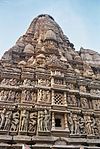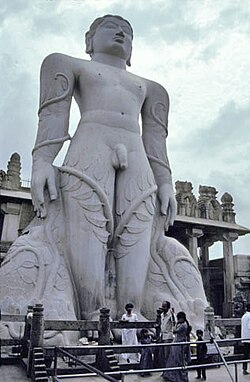Various lists of the Wonders of the World have been compiled over the ages to catalogue the most spectacular man-made constructions and natural things in the world. But, for the first time theTimes of India (TOI) News paper carried out a SMS poll, from 21 July to 31 July 2007, to vote for the seven greatest wonders of India, out of a list of 20 identified ancient or mediaeval sites for the purpose. The Seven Wonders of India (four of them are UNESCO World Heritage Sites) have now been chosen by the readers of Times of India (TOI) only. The winners range from a majestic monolith to places of worship, a mausoleum and a university.[1]
Except for the Golden Temple and the Taj Mahal, the Seven Wonders are all located in small towns or in the countryside. However, four of the twenty monuments listed for voting are located in three metropolitan area, such as Delhi's Lotus Temple and Qutub Minar, the Victoria Terminus at Mumbai and the Howrah Bridge at Kolkata.
Winners[edit]
The seven wonders of India, in the order of their voting are as follows:
| Wonder | Location | Image |
|---|---|---|
| Gomateshwara | Shravanabelagola, Karnataka, India |  |
| Harmandir Sahib | Punjab, India |  |
| Taj Mahal | Agra, India |  |
| Hampi | Vijayanagara, Karnataka, India |  |
| Konark Sun Temple | Orissa, India |  |
| Nalanda | Bihar, India |  |
| Khajuraho | A town in chattarpur district of Madhya Pradesh, India |  |
Bahubali (Gomateshwara)[edit]
Main article: Bahubali
Further information: Shravanabelagola and Mahamastakabhisheka
The colossal monolithic statue of Gomateshwara (Shravanabelagola is a synonymous word), also called as Bahubali the Jain saint, created around 983 C.E by Chamundaraya, a minister of the Ganga King, Rachamalla (Raachmalla Sathyavaakya IV 975-986 C.E) is located atop the Chandragiri hill (618 steps climb leads to the monolith on the hill), near the town of Shravanabelagola in Karnataka state. This statue is said to have been carved out of a single block of fine-grained white granite and is considered of great religious significance because Jains believe Bahubaliwas the first to attain moksha (freedom from cycle of birth and death). The image stands on a lotus. It has no support up to the thighs and is 60 feet (18 m) tall with the face measuring 6.5 feet (2.0 m). The statue is completely in the nude in the Jain custom and is visible from a distance of 30 km. With the serene expression on the face of the image, its curled hair with graceful locks, its proportional anatomy, the monolith size, and the combination of its artistry and craftsmanship have led it to be called the mightiest achievement in sculptural art in medieval Karnataka[2] It is the largest monolithic statue in the world.[3]
The neighboring areas of Shravanabelagola, apart from the Gomateshwara statue, have Jaina bastis and several images of the Jaina Tirthankars. A beautiful view of the surrounding areas could be seen from the top of the Chandragiri Hill. Every 12 years, thousands of devotees congregate here to perform the Mahamastakabhisheka, a spectacular ceremony in which the thousand-year-old statue is anointed with milk, curds, ghee, saffron and gold coins. The anointing last took place in February 2006, and the next ceremony will occur in 2018.[4]
Harmandir Sahib[edit]
Originally built in 1574, the site of the Gurdwara was surrounded by a small lake in a thin forest. Mughal Emperor Akbar, who visited the third Sikh Guru, Guru Amar Das, in the neighbouring town of Goindval, was so impressed by the way of life in the town that he gave a jagir (the land and the revenues of several villages in the vicinity) to the Guru's daughter Bhani as a gift on her marriage to Bhai Jetha, who later became the fourth Sikh Guru, Guru Ram Das ji. Guru Ram Das enlarged the lake and built a small township around it. The town was named after Guru Ram Das as Guru Ka Chak', Chak Ram Das or Ram Das Pura.
During the leadership of the fifth Guru, Guru Arjan (1581–1606), the full-fledged Gurdwara was built. In December 1588, Guru Arjan initiated the construction of the Gurdwara. The foundation stone was laid by none other than Guru Arjan Sahib himself in December 1588. It is a common misconception that the foundation stone was laid by the Sufi saint Mian Mir of Lahore.[5][6][7]
Some of the architectural features of the Harmandir Sahib were intended to be symbolic of the Sikh worldview.[8] Instead of the normal custom of building a Gurdwara on high land, it was built at a lower level than the surrounding land so that devotees would have to go down steps to enter it.[8] In addition, instead of one entrance, Sri Harmandir Sahib has four entrances.[8]
The Gurdwara was completed in 1604. Guru Arjan, installed the Guru Granth Sahib in it and appointed Baba Buddha as the first Granthi (reader) of it on August 1604. In the mid-18th century it was attacked by the Afghans, by one of Ahmed Shah Abdali's generals, Jahan Khan, and had to be substantially rebuilt in the 1760s. However, in response a Sikh Army was sent to hunt down the Afghan force. Both forces met each other five miles outside Amritsar; Jahan Khan's army was destroyed.










0 comments:
Post a Comment